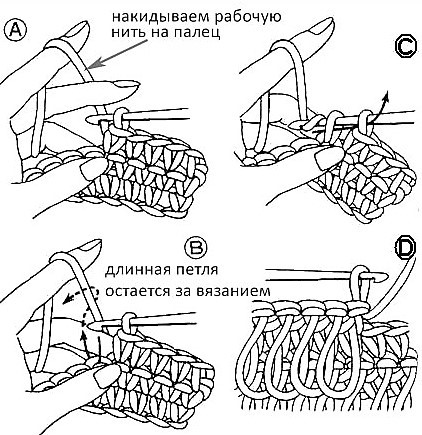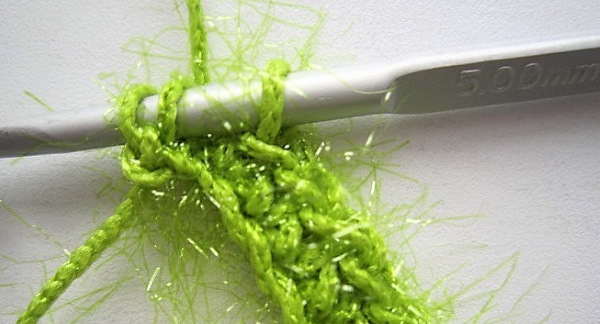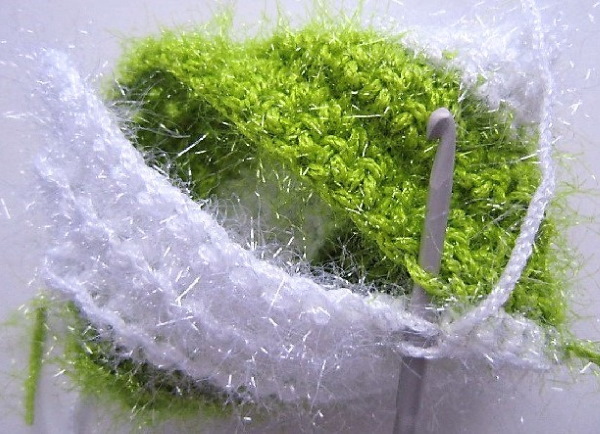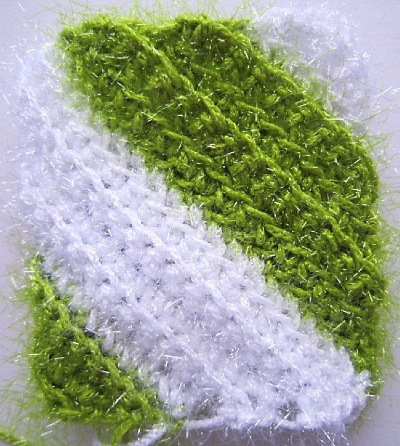Hand-made items are cheaper than those that are available for sale. To knit a pair of washcloths, you will need a skein of yarn worth 35-55 rubles. Step-by-step instructions for beginners will help handicraft lovers master crochet skills.
Yarn for washcloths
You can use both natural and artificial materials to knit washcloths. Natural washcloths are more useful, but they serve much less, since pathogenic organisms start in them, they can rot and mold. Their maximum service life is 1 month, after which the washcloth should be replaced with a new one.
Washcloths made from synthetic threads last much longer, it is recommended to use them for no more than 3 months, although the strength can be maintained for more than a year:
- Cotton and linen. Cotton washcloths are soft, suitable for children and people with very delicate and sensitive skin, or suffering from skin diseases. Linen washcloths have a beneficial effect on blood circulation.
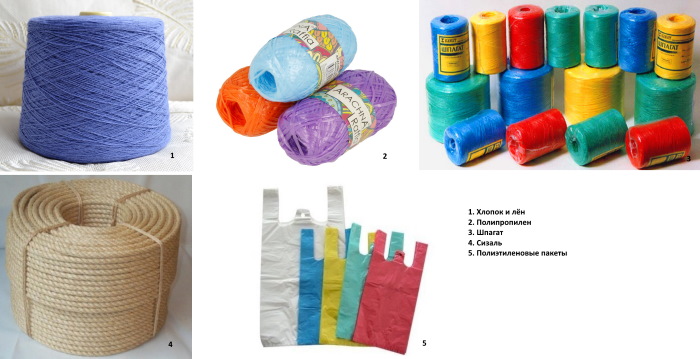
- Polypropylene. It is considered a fairly strong synthetic material. Washcloths made from such threads lather well and are able to remove sweat, fat, and dead cells perfectly.
- Leg-split. Polypropylene twine is more suitable for washcloths, it is very durable. But natural twine will also do: jute or linen.
- Sisal. Derived from the leaves of Agave sisalana, this material is more suitable for flat massage sponges, which are good for rough skin.
- Plastic bags. Knitting washcloths from this material is considered a utilitarian handicraft that brings benefits and helps to get rid of unnecessary things. Washcloths knitted from bags are suitable for people with delicate and sensitive skin. It is not recommended to use them when using scrubs.
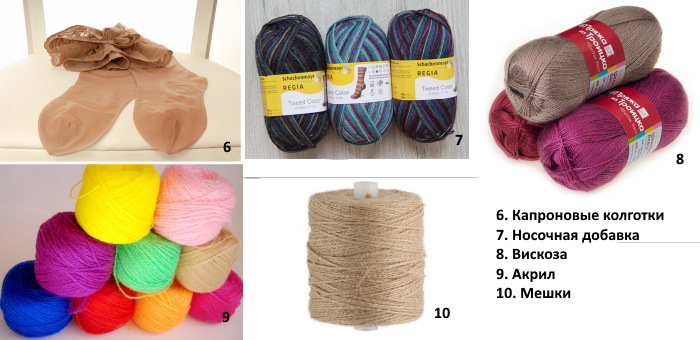
- Nylon tights. Fragile women's products quickly break down and have to be changed frequently. Craftswomen do not throw them away, but use them to knit washcloths, cutting them into strips 3-4 cm wide. It is better if the washcloths made from tights are flat.
- Sock supplement. The material is durable enough to be used with any sponge, even those intended for washing dishes.
- Viscose. Washcloths made from artificial fiber, for the production of which pine or bamboo wood is used, are quite durable and beautiful.
- Acrylic. Sponges made of acrylic, a synthetic polymer fiber produced from petroleum products, are very durable and reliable.
- Bags. If you don't have yarn at hand, you can unravel a used bag. Sugar and flour bags, pre-washed, are suitable. The washcloth will turn out strong and beautiful.
Crochet hooks are selected to match the threads used. It is desirable that they have rounded heads, not pointed ones.
The finished sponges should be kept in boiling water for 10 minutes. They will become more pleasant and will lather better.
How to crochet hard and soft
A crocheted washcloth may be difficult for beginners, but step-by-step instructions will help you cope with the task. The main thing is the ability to knit a lush column.
For a double-sided washcloth, a hook No. 4 and any polypropylene yarn are suitable. The future washcloth can be either single-color or beautifully multi-colored.
The sides are different - one is hard, knitted lengthwise, and the other is soft, knitted across:
- Step 1 – chain. The length of the future washcloth will depend on the number of loops cast on.
- The 1st and 2nd rows consist of sc.
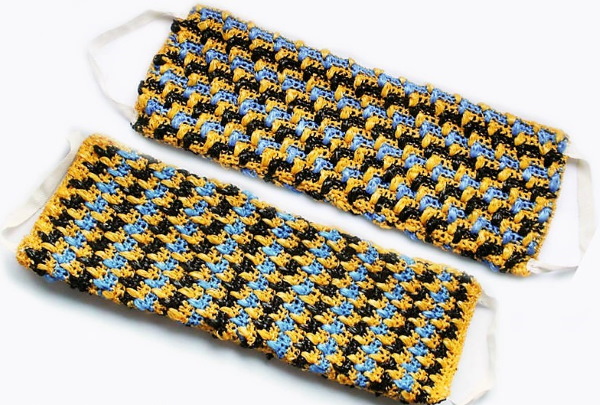
- Row 3. If the washcloth is multi-colored, then first a chain stitch is knitted with 2 threads, followed by 2 sc, then a lush column. It is knitted from the initially knitted chain.
To form a lush column, knit 5 dc and secure them with a chain stitch. Next come 3 sc and knit another lush column. This continues until the row ends.
- Row 4. Knit the 1st loop as an air loop, then knit sbn into the loops of the previous row. For a multi-colored washcloth, the last loop is knitted with 2 threads at once.
- Row 5 is knitted again with the thread of the first color, the air loop is also. Next comes the alternation of 3 sc and a lush column, which is knitted from the loop of the last knitted row of the same color.
- Row 6 is knitted like row 4.
- Row 7. If the washcloth is knitted in different colors, a third color thread is introduced into the work and row 5 is repeated.
- Row 8 is similar to row 4.
- Continue knitting until the washcloth reaches the required width.
To knit the soft side, you need to start working from the side of the resulting fabric. This side is knitted in the same way as the previous one, but the lush columns are made from three dc, not five. And they will alternate not with 3 sbn, but with 2. Having knitted the 2nd side, both halves are folded and either crocheted along the perimeter together, or sewn from the inside. At the knitter's discretion.
If the halves were sewn together, the result will be a tube and the holes still need to be crocheted and then the handles tied. You can sew on cotton braid as handles. To make the sponge soft, scald it with boiling water.
With loops extended
Beginner knitters are better off starting with a flat sponge, which will have elongated loops on only one side. Due to these loops, it will be more voluminous. They can be in each row, through 1, or even through 2 rows. In order to save yarn, the loops can be diluted with single crochets.

A crochet washcloth for beginners (step-by-step instructions help to understand the sequence of work) of a volumetric type is more complicated, but the proposed drawings will help to master it.
For a voluminous washcloth in the form of a hollow pipe, you will need about 300 m of polypropylene and a #3 hook. As with most washcloths, knitting begins with closing the air loops into a ring (there should be 40 of them here).
Since it is knitted in a circle, the transition to the next row is carried out through air loops that form a rise. The same procedure is used when knitting other washcloths.
7-8 rows (more or less is possible) are knitted with sc. You can also use dc. Then the extended loops are knitted (the knitting technique is shown in the pictures below). The loops can remain either in front of the work or behind it. The extended loops are knitted to the desired length. The work ends with the same number of rows of sc (or dc) as it began with.
 |
|
|
To knit the handles, 30-40 air loops are made, preferably in 2 threads. The height of the loops can be made very different, the volume and "fluffiness" of the future washcloth depends on it.
Double crochet stitches
When knitting almost any washcloth, you will encounter double crochet stitches.
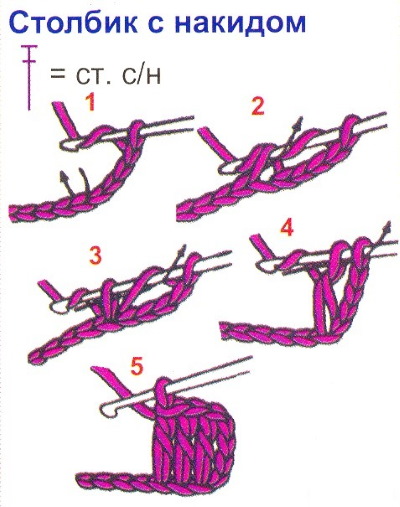 A very simple washcloth can be made using only them. You will need synthetic twine, hook No. 3, acrylic or viscose.
A very simple washcloth can be made using only them. You will need synthetic twine, hook No. 3, acrylic or viscose.
It is recommended to knit in 2 threads. The washcloth will be quite hard.
Knitting step by step:
- From the 40 chain stitches collected, dc is knitted.
- Knitting is done in a spiral to the required width.
- On the turns, 3 dc are knitted into one loop, this will help to avoid tightening.
- The last row is knitted in the opposite direction. Having knitted one of the sides, a chain for the handle is knitted, then knitting goes on the other side and ends with knitting the second handle.
- After attaching the handle, the thread is cut and secured.
With a "bump" pattern
To knit such a beautiful washcloth, you should prepare a hook No. 5, with which you first knit a chain of 36 loops, which is then closed into a ring.
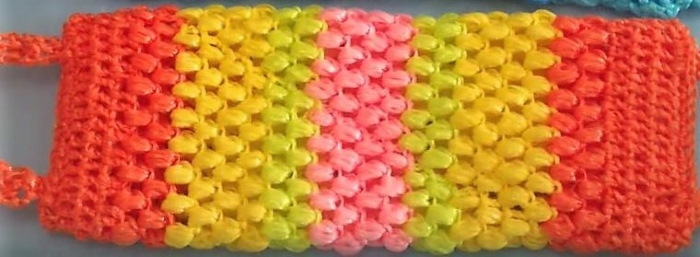
Knitting step by step:
- The 1st row is knitted with single crochets.
- 2-4th rows: columns, but with a yarn over.
- The main pattern details - cones - are knitted to the required length. To form a cone, 3 yarn overs are formed, which then need to be knitted together. 2 columns are skipped, and another cone is formed.
- The bumps on the sponge should be in a checkerboard pattern.
- Knitting is circular. Finish it as you started: rows 1-4 are knitted in reverse order.
- The handles can be knitted separately and then attached, or you can start knitting with one handle and finish the product by knitting the other.
With a spiral pattern
A chain of 47 loops is knitted with a double thread, which is then closed into a ring.

Knitting a washcloth:
- 1st row. Single crochet stitches are knitted into each loop of the chain.
- The 2nd and all subsequent rows are knitted with already elongated loops, knitted into each column. After knitting 6 loops, a thread of another color is introduced into the work, and 6 loops are knitted again. The next 6 loops are again knitted with the first color. And until the end of the row, there is an alternation of different colors.
- In each row there is a shift of color by 1 loop. The length of the washcloth can be any. The knitting ends with a row of double crochets.
You can make all the stripes in different colors, the width of the stripes can also change.
Children's washcloth toy
A crochet washcloth (step-by-step instructions for beginners are provided below), knitted in the shape of a hedgehog, will not be difficult if this pattern is used when knitting.
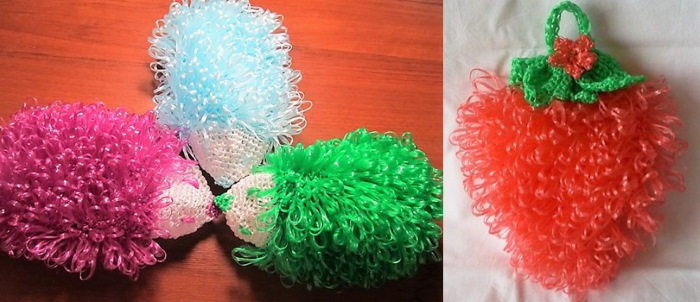
Knitting step by step:
- To start knitting, you should knit a chain of 32 air loops and connect the first and last loops.
- The first 2 rows are knitted with single crochets.
- Then 30 rows are knitted with “fur” (using the method described above).
- To knit the muzzle, you will need white. 5 rows are knitted with simple columns, after which you should decrease 4 loops in each row.
- The thread is cut and secured. The eyes and nose are decorated with the main color thread using a needle.
Berry-shaped washcloths also look chic.
In the form of a ball
A crochet washcloth (for beginners, step-by-step instructions may be required only at the beginning of knitting) in the form of a ball can be made in a short period of time, since it has a small amount of work.
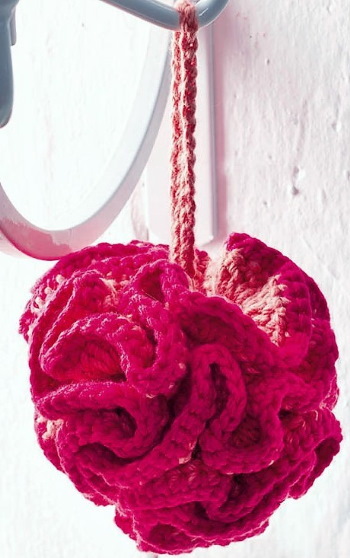
To make the finished washcloth 11 cm in diameter, you need to take 50 g of cotton yarn and a number 4 hook.
The spherical shape is achieved by knitting several columns into one loop. This creates natural folds.
The execution begins with knitting 5 air loops, which are then closed into a small ring.
Another closed chain consisting of 40 loops will come in handy so that the washcloth can be hung to dry.
All circular rows begin with lifting using air loops (this method is described above).
A single crochet is replaced by one chain stitch. To replace a double crochet, 3 chain stitches are knitted. The rows are finished with a slip stitch.
Step by step knitting:
- 1st row: in a small (five-loop) ring you need to knit 18 single crochet stitches.
- 2nd and 3rd rows: in each of the knitted loops of the previous row you need to knit 3 single crochets.
- As a result, after the 2nd row there should be 54 loops, after the 3rd – 162 loops.
- The 4th row is knitted entirely with single crochets.
You can get a more voluminous washcloth by replacing simple columns with columns with 1 or 2 yarns.
From plastic bags
A large selection of multi-colored polyethylene bags, different in texture, are used for knitting washcloths. You can take already used ones, or you can buy new ones. It is better to choose softer ones, which do not have handles and ties.
You can choose any shape of washcloths. The main thing is to prepare yarn from them correctly.
| The bag must be folded several times to one side, leaving about 2.5 cm. | 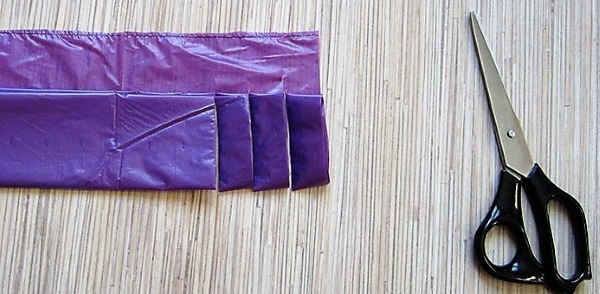 |
| The rolled up part of the package is cut into strips 2.5-3 cm wide, not cutting all the way through. |  |
| The strips are straightened along their length. | 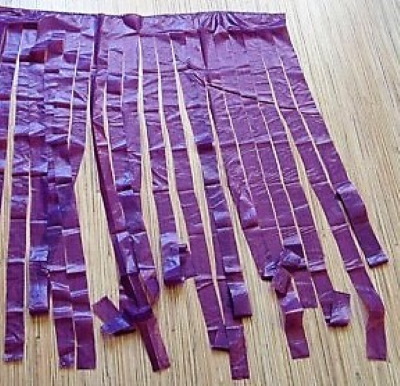 |
| Then the uncut part is straightened out and the strips are cut diagonally. The cuts go from the cut of the 1st strip to the 2nd, from the cut of the 2nd strip to the 3rd, and so on. | 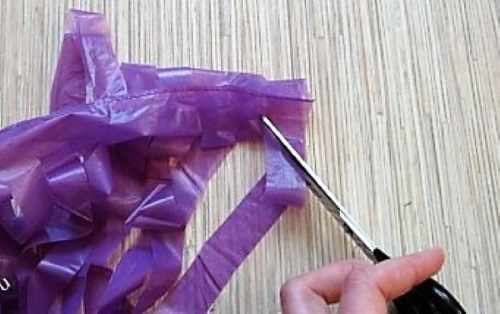 |
| It should turn out like this. | 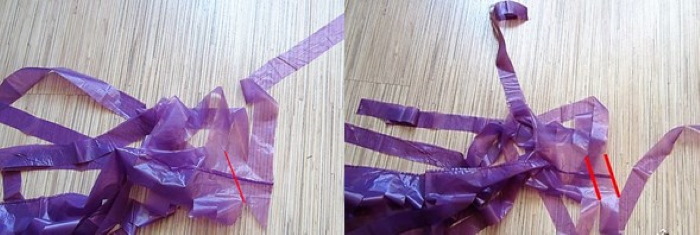 |
| The arrow shows the seam of the package. | 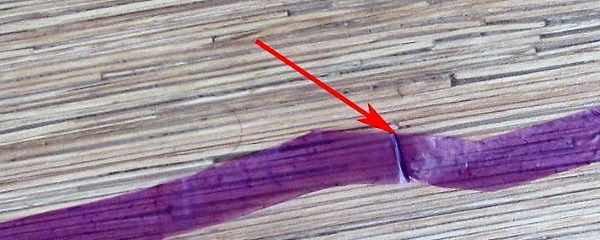 |
Then the strips are wound into balls and you can start working. For a washcloth measuring 70*15 cm, you will need about 30 medium bags. You can knit in any way, you can add elongated loops for strength and looseness.
For washing dishes
A crochet washcloth (for beginners, step-by-step instructions will help you make the product correctly) for washing dishes will require you to stock up on 20 g of synthetic yarn and hooks No. 4 and No. 5.
| 21 loops are cast on with hook No. 5. You need to leave a tail for subsequent sewing. |  |
| All rows are knitted with sc. The difference is that in the front rows they are done behind the back wall of the loops, and in the back rows behind the front wall. In the 1st row, 2 sc are made into the second loop. |  |
| Sc is knitted into each loop except the last two. |  |
| The hook must be inserted into both remaining loops at once and the working thread is pulled through them, then one loop is knitted from the two. |
|
| Next, a chain stitch is knitted for lifting. There should be 20 loops in the work. | 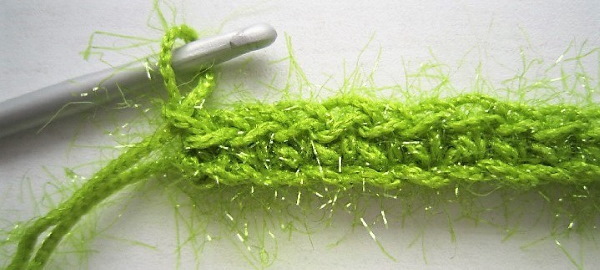 |
| After turning the work, knit the 2nd row (purl).
The hook is inserted immediately into the first 2 loops, which are knitted in the manner described above, sc. | 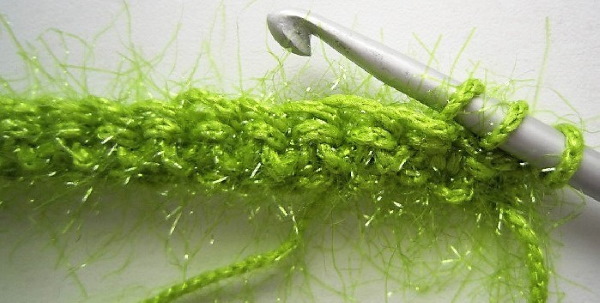 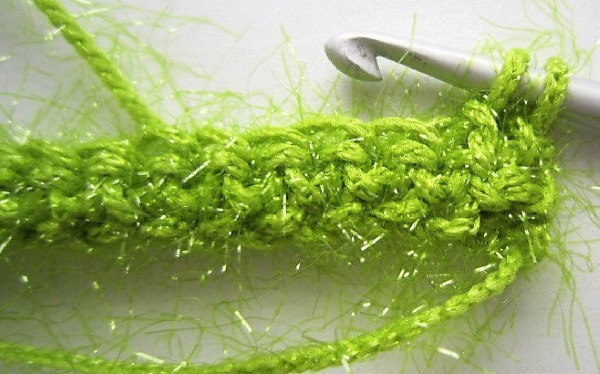 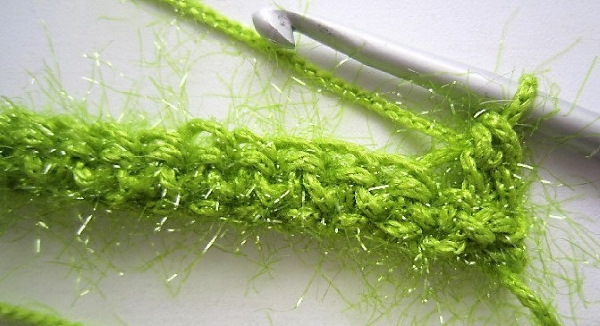 |
| Next, from each loop, knit a sc. The last loop does not need to be knitted. | 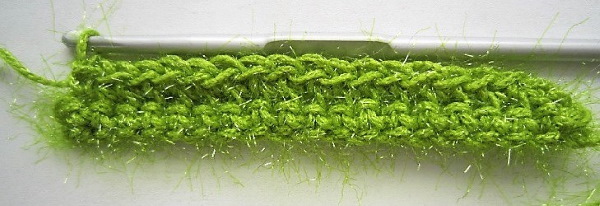 |
| From the remaining loop, 2 sc are knitted. And then an air loop for lifting. | 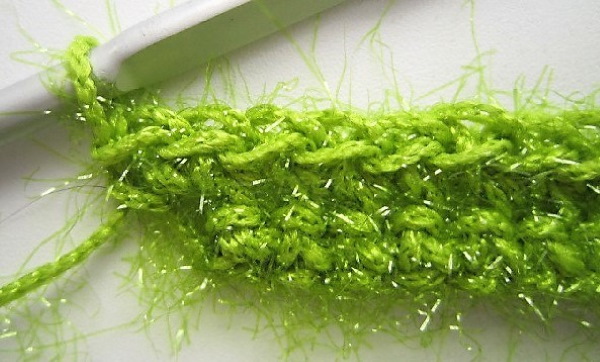 |
| Row 3 is knitted like row 1. From the last 2 loops, 1 sc is made. |  |
| The 4th row is knitted like the 2nd. | 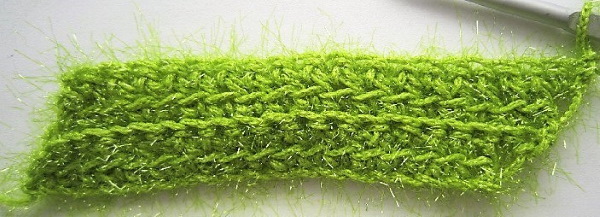 |
| When knitting a single-color washcloth, rows 1 and 2 alternate. In total, you need to knit 21 rows.
If the washcloth is planned to be two-colored, then the colors alternate through any number of rows (as desired). When changing colors, the air loop for lifting is knitted in a new color. The last strip needs to be knitted 1 row longer, this is for sewing the product. | 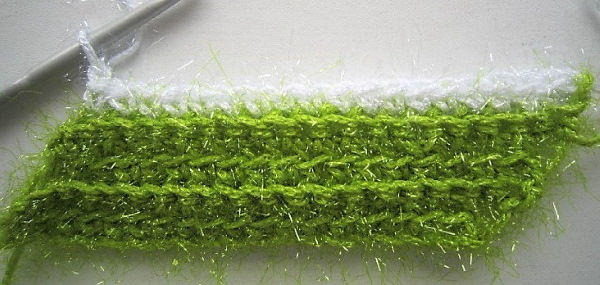 |
| In total, 21 rows are knitted. The result is a parallelogram. | 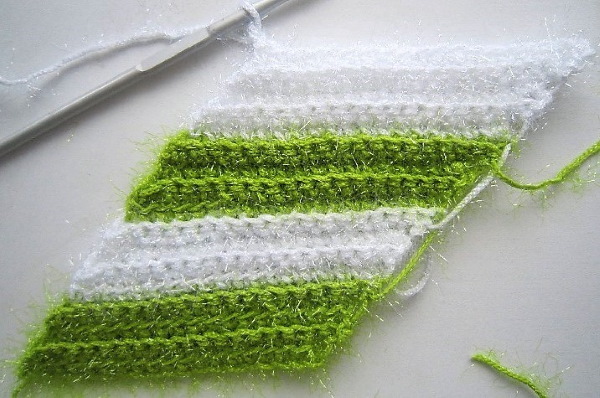 |
| The product is folded so that the threads from the beginning and end of the knitting are together. This forms a hollow tube. | 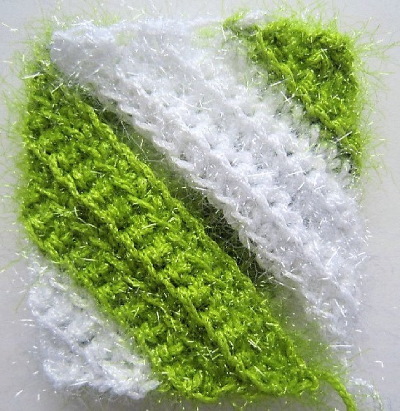 |
| Now you need to connect the product. This is done using the thread left at the beginning of knitting.
For this you will need a hook of a smaller diameter. | 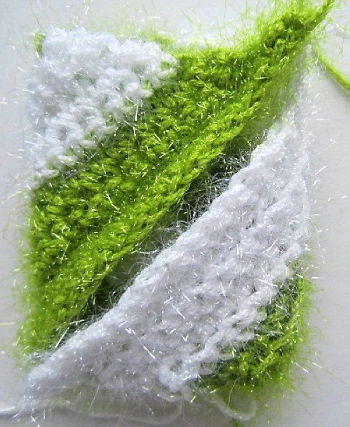
|
| It is better to make the seam from the inside. Then turn the product inside out. | 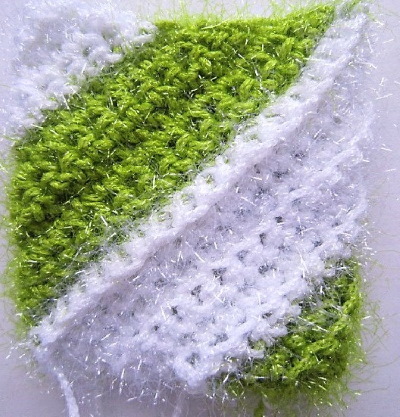
|
| All that remains is to tighten the holes, similar to tightening the crown of a hat.
This can be done by using a basting stitch along the edges of the holes. | 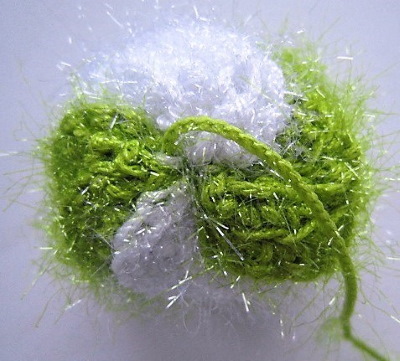 |
| The product is flattened, the center is secured by tightening and tying together the threads that were used to sew the holes. | 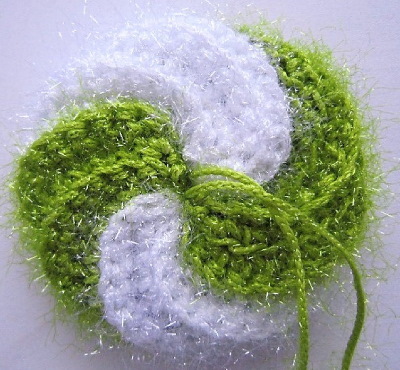 |
| View of the washcloth from the other side. | 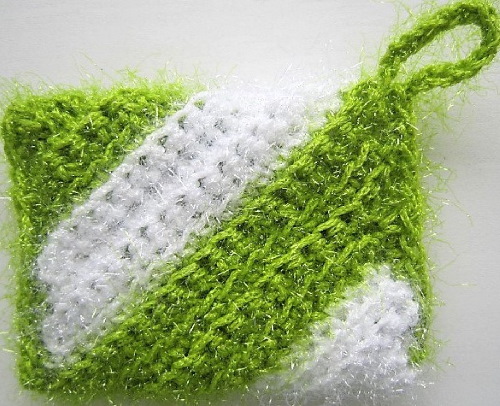 |
| From the remaining threads you can knit a loop for hanging.
You can leave the washcloth in a rectangular shape, then the top and bottom are crocheted with sc. The multi-colored washcloth looks beautiful. | 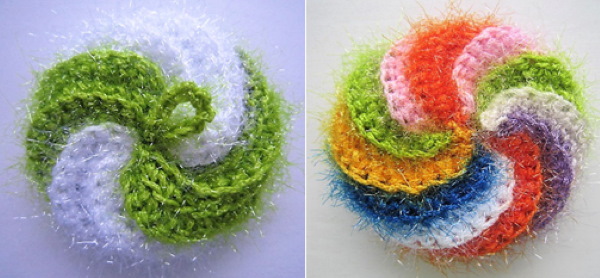 |
Mitten - washcloth
For knitting creative washcloths-mittens, it is preferable to take natural materials. These can be cotton, sisal or flax. Synthetic yarn will also do.
Step-by-step knitting:
- You should start with a chain, the length of which is determined by the size of your hand.
- Knitting is done in a circle. Single crochets are used.
- The fabrics for the fingers (or one finger) are also knitted in a circle.
- For a child, a knitted mitten is designed in the form of some funny animal. How to do this is shown below.
 | 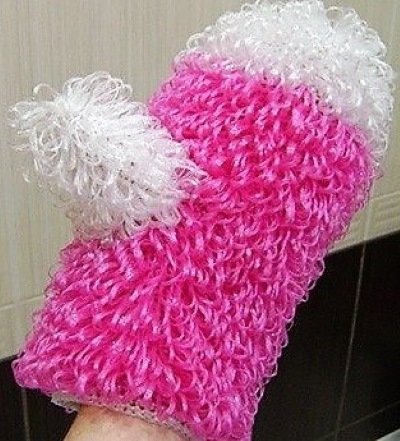 If the mitten is knitted from artificial yarn, then elongated loops will look more beautiful. |
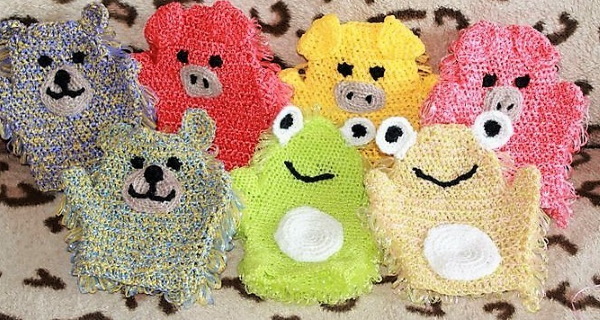 | |
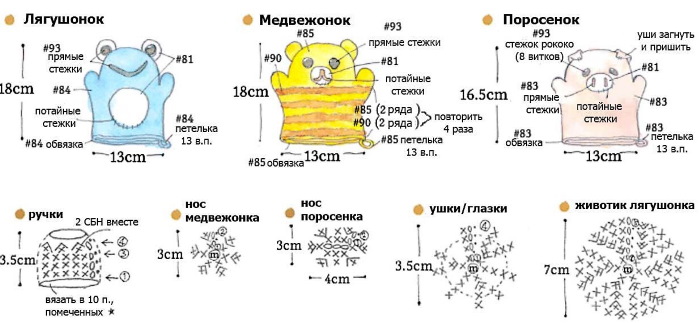 | |
Round
Round (or oval) washcloths, knitted from stiff threads, are well suited for peeling. For convenience, they must have loops for the hand. The proposed scheme can be used as a basis. To make the washcloth look more "lush", alternating columns with elongated loops is used.
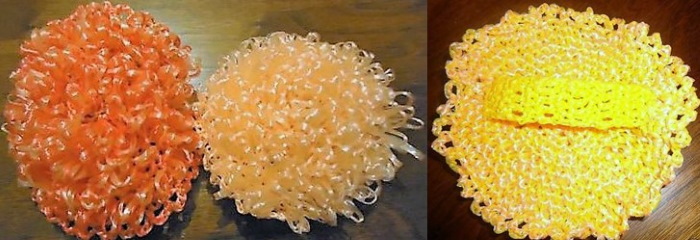
In the 3rd circle, 2 are knitted from each loop. As a result, the number of columns will double. The 4th circle is knitted without increases. In the following circles, the knitting methods of the 3rd and 4th circles alternate.
The penultimate row: 2 dc are knitted from one loop, one from the next. In the last row, 2 dc alternate with 2 air loops. The final step is knitting the handle.
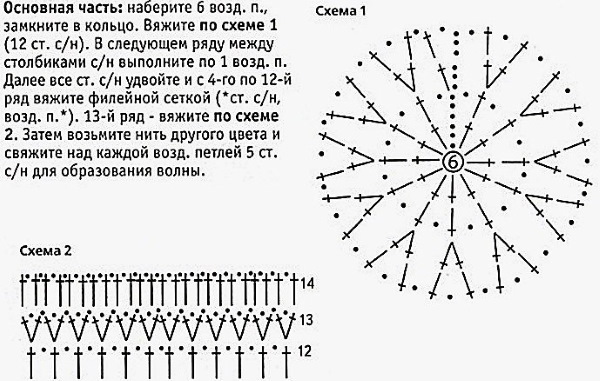
To prevent the ends of synthetic threads from unraveling, they are secured with a hook, then heated with a lighter or candle. When the thread begins to melt, it is pressed against the product.
A washcloth crocheted with your own hands, using step-by-step instructions for beginners, will be a great addition to a gift for family and friends.
Author: Cutie
Article formatting:Natalie Podolskaya
Video about crocheting washcloths
Crochet washcloth for beginners - instructions, photos:

